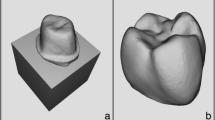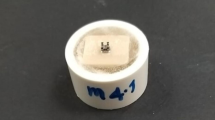Abstract
Objectives
To evaluate the critical bond strength (σ) of ceramic and metal brackets to a lithium disilicate-based glass–ceramic.
Materials and methods
Two hundred and forty ceramic specimens (IPS e-max CAD) were randomly distributed in 12 experimental groups (n = 20). Two ceramic brackets (monocrystalline, BCm; and polycrystalline, BCp) and a metal bracket (BM) were bonded to glass–ceramic specimens after one of the following surface treatments: HF—hydrofluoric acid applied for 60 s; S—silane applied for 3 min; HFS—HF followed by S; and MDP—application of an adhesive containing a phosphate monomer (MDP). All brackets were bonded to the treated glass–ceramic using a resin cement, stored in 37 °C water for 48 h before shear bond strength testing. Optical (OM) and scanning electron (SEM) microscopies were used for fractographic analysis. Data was statistically analyzed using Kruskal–Wallis and Student–Newman–Keuls (α = 0.05).
Results
BCm bonded to glass–ceramic treated with either HFS or HF showed the highest median σ values, respectively, 10.5 MPa and 8.5 MPa. In contrast, the BCp bonded to glass–ceramic treated with MDP showed the lowest median σ value (0.8 MPa), which was not statistically different from other MDP-treated groups.
Conclusions
The failure mode was governed by the glass–ceramic surface treatment, not by the bracket type. Quantitative (σ values) and qualitative (fracture mode) data suggested a minimum of 5 MPa for brackets bonded to glass–ceramic, which is the lower critical limit bond strength for a comprehensive orthodontic treatment.
Clinical relevance
Bonding brackets to glass–ceramic requires micromechanical retention.




Similar content being viewed by others
References
Bishara SE, Ostby AW (2010) Bonding and debonding from metal to ceramic: research and its clinical application. Semin Orthod 16:24–36. https://doi.org/10.1053/j.sodo.2009.12.009
Klocke A, Kahl-Niecke B (2005) Influence of force location in orthodontic shear bond strength testing. Dent Mater 21:391–396. https://doi.org/10.1016/j.dental.2004.07.004
Kokadereli I, Canay S, Akça K (2001) Tensile bond strength of ceramic orthodontic brackets bonded to porcelain surfaces. Am J Orthod Dentofacial Orthop 119:617–620. https://doi.org/10.1067/mod.2001.113655
Ajlounia R, Bishara SE, Oonsombact C, Solimand M, Lafoone J (2005) The effect of porcelain surface conditioning on bonding orthodontic brackets. Angle Orthod 75:858–864
McCabe JF, Walls AWG (2008) Applied dental materials, 9th edn. Wiley-Blackwell, Oxford
Finnema KJ, Özcan M, Post WJ, Ren Y, Dijkstra P (2010) In-vitro orthodontic bond strength testing: a systematic review and meta-analysis. Am J Orthod Dentofac Orthop 137:615–622. https://doi.org/10.1016/j.ajodo.2009.12.021
Della Bona A, Kochenborger R, Di Guida LA (2018) Bond strength of ceramic and metal orthodontic brackets to aged resin-based composite restorations. Curr Dent 1:1–6. https://doi.org/10.2174/2542579X01666180919121640
Ogaard B, Bishara SE, Duschner H (2004) Enamel effects during bonding–debonding and treatment with fixed appliances. In: Graber TM, Eliades T, Athanasiou AE (eds) Risk management in orthodontics: expert’s guide to malpractice, 1st edn. Quintessence Publishing Co, Inc., Carol Stream, pp 19–46
Karamouzos A, Athanasiou A, Papadoulos MA (1997) Clinical characteristics and properties of ceramic brackets: a comprehensive review. Am J Orthod Dentofac Orthop 112:34–40
Bishara SE, Me O, Von Wald L, Jacobsen JR (1999) Comparison of the debonding characteristics of two innovative ceramic bracket designs. Am J Orthod Dentofac Orthop 116:86–92
Pickett KL, Sadowsky PL, Jacobson A (2001) Orthodontic in vivo bond strength: comparison with in vitro results. Angle Orthod 71:141–148
Yadav S, Upadhyay M, Borges GA, Roberts WE (2010) Influence of ceramic (feldspathic) surface treatments on the micro-shear bond strength of composite resin. Angle Orthod 80:765–770
Swartz ML (1988) Ceramic brackets. J Clin Orthod 22:82–88
Scott GE (1988) Fracture toughness and surface cracks. The key to understanding ceramic brackets. Angle Orthod 58:5–8
Bordeaux JM, Moore RN, Bagby MD (1994) Comparative evaluation of ceramic bracket base designs. Am J Orthod Dentofac Orthop 105:552–560. https://doi.org/10.1016/S0889-5406(94)70139-3
Johnson G, Walker M, Kula K (2005) Fracture strength of ceramic tie wings subjected to tension. Angle Orthod 75:95–100. https://doi.org/10.1043/0003-3219(2005)075<0095:FSOCBT>2.0.CO;2
Chen HY, Su MZ, Chang HF, Chen YJ, Lan WH, Lin CP (2007) Effects of different debonding techniques on debonding forces and failure modes of ceramic brackets in simulated clinical set ups. Am J Orthod Dentofac Orthop 132:680–686
Kukiattrakoon B, Samruajbenjaku B (2010) Shear bond strength of ceramic brackets with various base designs bonded to aluminous and fluorapatite ceramics. Eur J Orthod 32:87–93
Anusavice KJ, Shen C, Rawls R (2013) Phillips science of dental materials. 12ed. Elsevier, St Louis
Reynolds JR (1975) A review of direct orthodontic bonding. Br J Orthod 2:171–178. https://doi.org/10.1080/0301228X.1975.11743666
Saraç YS, Külünk T, Eledakq-Tür S, Turk T (2011) Effects of surface-conditioning methods on shear bond strength of brackets bonded to different all-ceramic materials. Eur J Orthod 33:667–672
Zachrisson YO, Zachrisson B, Buyukyilmaz T (1996) Surface preparation for orthodontic bonding to porcelain. Am J Orthod Dentofac Orthop 109:420–430
Della Bona A, Anusavice KJ (2002) Microstructure, composition, and etching topography of dental ceramics. Int J Prosthont 15:159–167
Della Bona A, Anusavice KJ, Hood JAA (2002) Effect of ceramic surface treatment on tensile bond strength to a resin cement. Int J Prosthodont 15:248–253
Della Bona A (2009) Important aspects of bonding resin to dental ceramics. J Adhes Sci Technol 23:1163–1176. https://doi.org/10.1163/156856109X440146
Della Bona A, Shen C, Anusavice KJ (2004) Work of adhesion of resin on treated lithia disilicate-based ceramic. Dent Mater 20:338–344. https://doi.org/10.1016/S0109-5641(03)00126-X
Della Bona A (2009) Bonding to ceramics: scientific evidences for clinical dentistry. Artes Médicas, São Paulo
Queiroz JRQ, Benetti P, Özcan M, De Oliveira LFC, Della Bona A (2012) Surface characterization of feldspathic ceramic using ATR FTIR and ellipsometry after various silanization protocols. Dent Mater 28:189–196. https://doi.org/10.1016/j.dental.2011.10.009
Inokoshi M, Poiteuin A, De Munck J, Minakuchi S, Van Meerbeek B (2014) Bonding effectiveness to different chemically pre-treated dental zirconia. Clin Oral Investig 18:1803–1812. https://doi.org/10.1007/s00784-013-1152-7
Taufer C, Della Bona A (2018) Edge chipping resistance of ceramics bonded to a dentine analogue. J Mech Behav Biomed Mater 12:587–590. https://doi.org/10.1016/j.jmbbm.2018.11.010
Alessandretti R, Borba M, Benetti P, Corazza PH, Ribeiro R, Della Bona A (2017) Reliability and mode of failure of bonded monolithic and multilayer ceramics. Dent Mater 33:191–197. https://doi.org/10.1016/j.dental.2016.11.014
Della Bona A, Anusavice KJ, Mecholsky JJ Jr (2003) Failure analysis of resin composite bonded to ceramic. Dent Mater 19:693–699
Della Bona A, Anusavice KJ, Shen C (2000) Microtensile strength of composite bonded to hot-pressed ceramics. J Adhesive Dent 2:305–313
Hoshmand T, Van Noort R, Keshvad A (2002) Bond durability of the resin-bonded and silane treated ceramic surface. Dent Mater 18:179–188
Donassolo T, Demarco FF, Della Bona A (2009) Resin bond strength to a zirconia-reinforced ceramic after different surface treatments. Gen Dent 57:374–379
Salazar-Marocho SM, Studart AR, Bottino MA, Della Bona A (2010) Mechanical strength and subcritical crack growth under wet cyclic loading of glass-infiltrated dental ceramics. Dent Mater 26:483–490. https://doi.org/10.1016/j.dental.2010.01.007
Kao EC, Boltz KC, Johnston WM (1988) Direct bonding of orthodontic brackets to porcelain veneer laminates. Am J Orthod Dentofac Orthop 94:458–468
Kao EC, Johnston W (1991) Fracture incidence on debonding of orthodontic brackets from porcelain veneers. J Prost Dent 66:631–637
Herion DT, Ferracane JL, Covell DA Jr (2010) Porcelain surface alterations and refinishing after use of two orthodontic bonding methods. Angle Orthod 80:167–174. https://doi.org/10.2319/010909-19.1
Zelos L, Bevis RR, Keenan KM (1994) Evaluation of the ceramic/ceramic interface. Am J Orthod Dentofac Orthop 106:10–21
Quinn GD, Hoffmann K, Quinn JB (2012) Strength and fracture origins of a feldspathic porcelain. Dent Mater 28:502–511. https://doi.org/10.1016/j.dental.2011.12.005
Song JY, Park SW, Lee K, Yun KD, Lim HP (2013) Fracture strength and microstructure of Y-TZP zirconia after different surface treatments. J Prosthodont 110:274–280. https://doi.org/10.1016/S0022-3913(13)60376-5
Valian A, Moravej-Salehi E (2014) Surface treatment of feldspathic porcelain: scanning electron microscopy analysis. J Adv Prosthodont 6:387–394. https://doi.org/10.4047/jap.2014.6.5.387
Elekdag-Turk S, Sarac YS, Turk T, Sarac D (2007) The effect of a light emitting diode on shear bond strength of ceramic brackets bonded to feldspathic porcelain with different curing times. Eur J Orthod 29:299–303
Solderquist SA, Drummond JL, Evans CA (2006) Bond strength evaluation of ceramic and stainless steel bracket bases subjected to cyclic tensile loading. Am J Orthod Dentofac Orthop 129:e7–e12
Aksakalli S, Ileri Z, Yavuz T, Malkoc MA, Ozturk N (2015) Porcelain laminate veneer conditioning for orthodontic bonding: SEM-EDX analysis. Lasers Med Sci 30:1829–1834. https://doi.org/10.1007/s10103-014-1682-5
Özcan M, Finnema K, Ybema A (2008) Evaluation of failure characteristics and bond strength after ceramic and polycarbonate bracket debonding: effect of bracket base silanization. Eur J Orthod 30:176–182
Habibi M, Nik TH, Hooshmand T (2007) Comparison of debonding characteristics of metal and ceramic orthodontic brackets to enamel. An in vitro study. Am J Orthod Dentofac Orthop 132:675–679
Grewal Bach GK, Torrealba Y, Lagravère MO (2014) Orthodontic bonding to porcelain: a systematic review. Angle Orthod 84:555–560. https://doi.org/10.2319/083013-636.1
Della Bona A, van Noort R (1995) Shear versus tensile bond strength of resin composite bonded to ceramic. J Dent Res 74:1591–1596. https://doi.org/10.1177/00220345950740091401
Swartz ML (2007) Limitations of in vitro orthodontic bond strength testing. J Clin Orthod 41:207–210
Funding
The work was partially supported by Capes do Brazil and CNPq do Brasil (302587/2017-9).
Author information
Authors and Affiliations
Corresponding author
Ethics declarations
Conflict of interest
The authors declare that they have no conflict of interest.
Ethical approval
This article does not contain any studies with human participants or animals performed by any of the authors.
Informed consent
For this type of study, formal consent is not required.
Additional information
Publisher’s note
Springer Nature remains neutral with regard to jurisdictional claims in published maps and institutional affiliations.
Rights and permissions
About this article
Cite this article
Di Guida, L.A., Benetti, P., Corazza, P.H. et al. The critical bond strength of orthodontic brackets bonded to dental glass–ceramics. Clin Oral Invest 23, 4345–4353 (2019). https://doi.org/10.1007/s00784-019-02881-5
Received:
Accepted:
Published:
Issue Date:
DOI: https://doi.org/10.1007/s00784-019-02881-5




